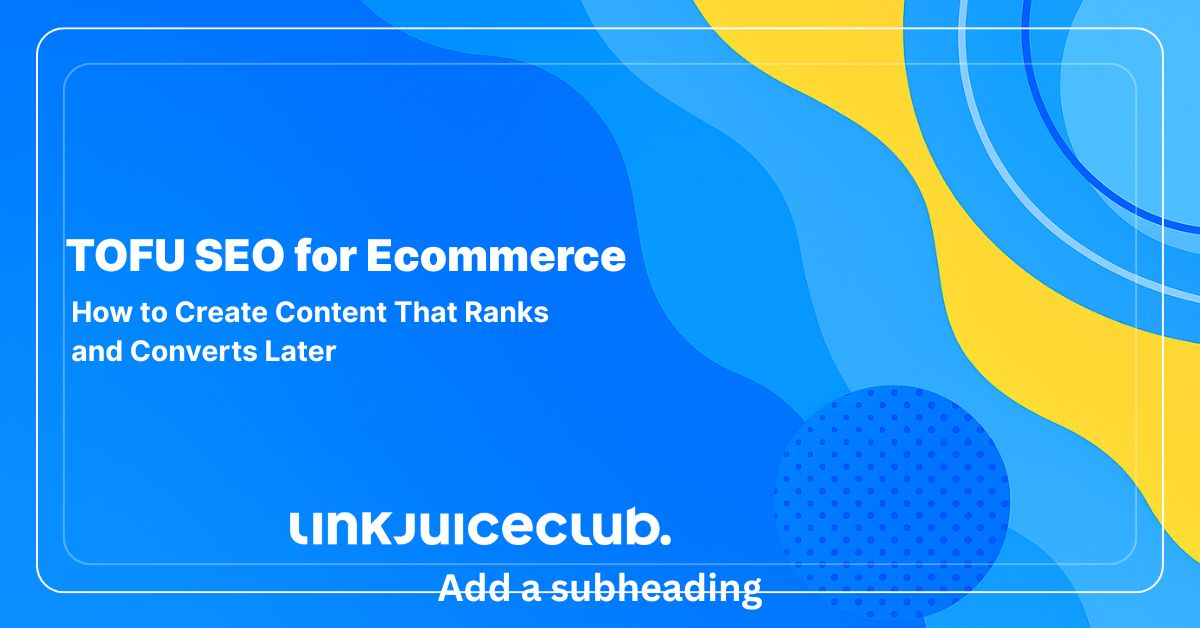
TOFU SEO for Ecommerce: How to Create Content That Ranks and Converts Later
For ecommerce sellers, content is more than words on a page — it’s the way to connect with potential buyers before they even know your brand. Online merchants can’t rely on handshakes or in-person conversations. Instead, content becomes the digital introduction that sparks trust and pulls leads into the funnel.
At the top of the funnel (TOFU), content is about scale. The goal is simple: reach as many people as possible, create awareness, and start relationships. With the right SEO foundation, TOFU content doesn’t just entertain — it gets discovered, ranked, and remembered. Without that visibility, even strong ideas fail to generate momentum.
Why Online Stores Can’t Skip Top-of-Funnel Content
Skipping TOFU is like trying to close a deal without ever meeting the prospect. At this stage, content sets the stage for every other interaction a buyer has with your brand. Without it, your store may only reach people who are already shopping with competitors.
TOFU content is what fills the pipeline. It creates the audience that later becomes warm leads and paying customers. By addressing broad topics and interests, you expand your brand’s visibility and start attracting people who might never have considered your products otherwise. For ecommerce sellers competing in crowded markets, this awareness advantage can be the difference between stagnation and growth.
What Sets TOFU Apart From Sales-Driven Copy
Content aimed at the bottom of the funnel is direct. It focuses on product specs, offers, and pricing — things buyers need when they’re already convinced. TOFU content works differently. It introduces, educates, and entertains without demanding a purchase.

At this early stage, shoppers are still figuring out what they like, what’s trending, or what problems they might need solved. They aren’t ready for transactional messaging. That’s why TOFU SEO content must strike a balance between relevance and accessibility. It needs to catch attention broadly while still hinting at your brand’s expertise. Done right, it lays the groundwork for buyers to return when they are ready.
The Real Job of TOFU in Ecommerce Growth
The biggest mistake brands make is treating TOFU as fluff. In reality, it has a measurable role: generating enough awareness to fuel conversions later. Not every reader or viewer will turn into a customer, but every impression adds to your potential buyer pool.
The math is simple: the more people you attract at the top, the more chances you have at the bottom. TOFU content expands visibility, builds trust, and starts the process of moving people down the funnel. Without it, ecommerce brands miss the chance to nurture relationships early — and those leads may end up with competitors instead.
Equally important, TOFU acts as a testing ground for messaging. By experimenting with broad topics and formats, brands can identify what resonates most with audiences before investing heavily in mid- and bottom-funnel campaigns. This insight not only strengthens future content but also ensures that marketing spend is directed toward strategies proven to capture attention.
Content Formats That Spark Attention at the Top of the Funnel
TOFU content needs to be broad, useful, and engaging. It should resonate with people regardless of whether they know your brand. For ecommerce, that often means leaning on content formats that naturally generate curiosity and clicks.
Some proven formats include:
- List posts: Quick, scannable rundowns of trends or products. Ex: “10 Things You Need to Know About the iPhone 7.”
- Why posts: Bold, opinion-driven pieces that justify a stance. Ex: “Why You Need: Flora Remedia.”
- How-to guides: Educational walkthroughs. Ex: “How to Ace This Winter’s Menswear Trends.”
- What posts: Objective explainers of trends or concepts. Ex: “The Return of the Stiletto.”
These formats perform because they provide value without requiring commitment. They appeal to curiosity, answer broad questions, and entertain. Once readers associate that value with your brand, they’re more likely to return for detailed content later.
SEO as the Lifeline of TOFU Visibility
Creating content without SEO is like opening a store in the desert — no one will find it. At the TOFU stage, where reach is the main objective, SEO is essential. It ensures your content is visible to people who have never heard of your brand but are searching for topics related to your niche.
SEO allows you to meet prospects where they already are: on Google. By targeting high-volume keywords, your content can ride existing search demand and attract large groups of potential customers. The more discoverable your TOFU content becomes, the more awareness and trust you build. Without SEO, you risk producing great ideas that remain invisible.
Laying Down a Practical SEO Blueprint for TOFU
Strong TOFU SEO starts with structure. Random publishing won’t cut it. Instead, content creation should follow a repeatable framework that ensures consistency and scalability.
For ecommerce brands, this blueprint breaks into three steps:
- Build a broad, high-opportunity keyword list.
- Match keywords to the right content type.
- Optimize content to compete with — and beat — existing results.
This approach turns content from guesswork into strategy. With every piece created under this framework, you improve both visibility and ROI.
Step 1: Turning Customer Insights Into Keyword Opportunities
Keywords form the backbone of TOFU SEO. The challenge is finding terms broad enough to attract new audiences but still connected to your products. That means thinking like your future customer before they even know they need you.
Some places to start:
- Analyze top-selling products on your site to see what trends are resonating.
- Run surveys with loyal customers to learn what brands or styles excite them.
- Monitor social media to identify what’s getting the most engagement in your niche.
- Study competitors using tools like Semrush to uncover their highest-ranking terms.
- Use Google autosuggest to discover related searches.
Gather as many options as possible — 50 to 1000 keywords — then narrow the list to 20–30 high-volume, high-opportunity terms. This ensures your TOFU content is designed to pull in the largest audiences.
Step 2: Letting Search Intent Shape Your Content Style
Keyword lists only become useful when paired with the right content formats. Search intent is the compass here. By studying what already ranks, you learn what type of content Google believes satisfies the query.
For example, if you sell bikes and the keyword is “pick a mountain bike,” a quick search shows that how-to guides dominate the results. That tells you exactly what format people want. Aligning your content with this intent increases your odds of ranking.
This doesn’t mean copying competitors. It means understanding the baseline expectations, then adding more depth, clarity, or originality to outperform them. Intent-driven formatting keeps your TOFU SEO content relevant and discoverable.
Step 3: Beating Page-One Content With Smarter Optimization
Ranking is competitive. To earn a spot on page one, your content must outperform what’s already there. That means analyzing top-ranking pages for subtopics, keyword usage, and structure, then building something better.
Use tools like Clearscope to identify common terms in high-ranking results. Or do it manually by reviewing the first 10 SERPs. From there, add unique value: more detailed insights, stronger formatting, fresher data, or original perspectives.
Search engines reward relevance and completeness. By going beyond the competition, you signal that your content deserves to rank higher, giving your brand more visibility with TOFU audiences.
From First Clicks to Future Customers: Why TOFU Matters
TOFU SEO content isn’t designed to drive immediate sales, but it does something just as powerful: it fills the funnel. By generating awareness and trust, it creates the audience that later converts when they encounter MOFU and BOFU content.
The reach you build at this stage determines the strength of your entire funnel. More awareness means more opportunities for nurturing and conversions later. And with SEO, you’re not just hoping people stumble upon your content, you’re ensuring they find it when they’re actively searching.
Complement your SEO with distribution tactics like link building, influencer collaborations, and guest blogging. The more you amplify your TOFU content, the more future customers you bring into your funnel.





